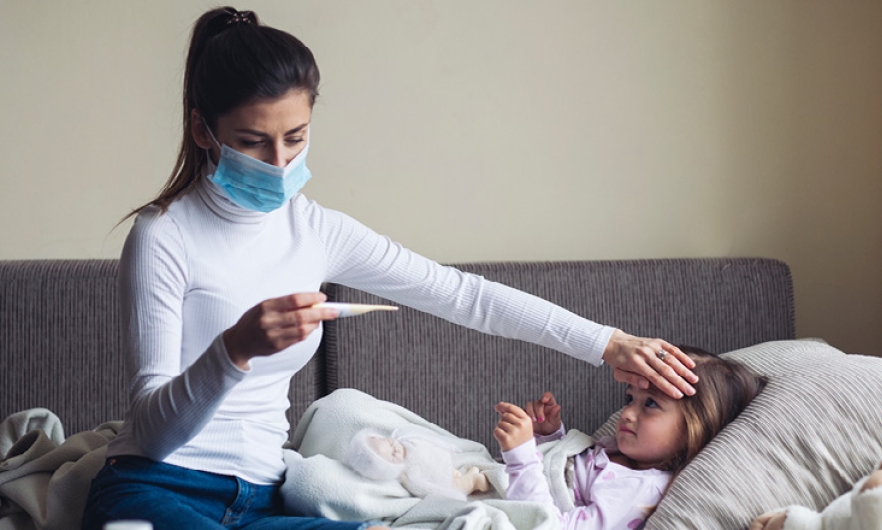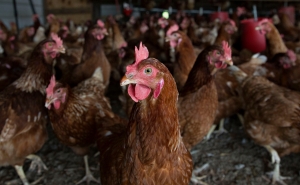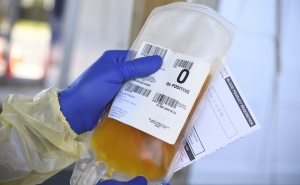Before COVID Comes Home: What You Can Do Now in Case Someone in Your Household Becomes Ill
With a slow vaccine rollout and cases on the rise, it’s time to prepare for the possibility of someone in your household getting COVID-19.

This article is part one of a series. Read part two here: What To Do if You Have COVID-19.
When her 6-year-old daughter complained of an earache and stomachache a few days after Halloween, Meg Grouzard didn’t even consider that it might be COVID-19.
Earache and stomachaches weren’t among the COVID symptoms she had heard of, and they hadn’t had any known exposure to COVID. But, a day later, her daughter spiked a fever and her symptoms weren’t getting better. After speaking with the family’s pediatrician, Grouzard took her daughter to a nearby urgent care center where they administered a COVID-19 test. A few anxious days later, Grouzard got a phone call from MD COVID, the Maryland Department of Health’s contact tracing campaign, saying her daughter’s test was positive.
Grouzard was shocked. Her immediate thoughts swirled around how to make her daughter comfortable while keeping the rest of the family safe. Because they had been so careful throughout the entire pandemic, they hadn’t planned for what to do if one of them was exposed to or came down with COVID-19. Grouzard admits there’s a lot she wishes she’d known ahead of time.
Most public health guidance is geared toward preventing infection. But it’s also important to have a plan for what to do if someone in the household is exposed to or has symptoms of COVID.
Here’s what you can do in advance so that you are ready if COVID comes home:
1. Know where you can get tested and how you’ll get the results.
Grouzard said that she hadn’t anticipated having to wait three days for test results for her daughter. It also took some time for her to find a place to get tests for herself and the rest of the family because their COVID experience took place in the weeks leading up to Thanksgiving.
There are two things you can do now to plan for testing if or when you or a family member needs it:
Visit your doctor’s office website, send an e mail, or call to ask:
- Is testing available at your practice?
- If so, do you have to have symptoms to be tested?
- Is there a cost associated with testing?
- What is the process–do I have to call in advance or have an appointment?
- How long does it take to receive results, and how will I receive them—via a portal to your electronic health record (e.g., MyChart), email, a phone call?
Or, you can visit your local (city, county, or state) health department’s website to see if there is testing available near you. You can also call them to ask the same questions above.
2. Work out a plan in advance for quarantine and isolation within your household.
Grouzard says that the MD COVID representative who called with the positive test result also gave her useful information about quarantining and a list of places to call for more information, such as the county board of health.
You can also call your primary care physician, who should be able to answer questions about how to isolate and quarantine and what to do if symptoms worsen.
With advice from the pediatrician, Grouzard and her husband worked out a plan for isolation and quarantine with their three kids. Although her daughter was the only one with a positive test, Grouzard noticed that their youngest son also seemed to be not feeling well. So, they divided into teams: Team Symptoms and Team Non-symptoms. Grouzard’s husband and middle child were on Team Non-symptoms and staked out the basement of the home as their living space. Grouzard stayed with her daughter and youngest son to form Team Symptoms in the master bedroom on another floor. The method helped their three young children understand the “rules” of isolation and quarantine.
The teams declared the kitchen and the main bathroom “common areas” and took turns using the space. Everyone wore masks and kept distance from those on the other team in the common areas and wiped down surfaces after using them.
Because the weather was still nice, as Grouzard’s daughter and son felt better the teams also took turns going outside. “That was the only time we laid eyes on each other,” Grouzard says.
Per the pediatrician’s guidance, Team Symptoms and Team Non-symptoms remained apart for 14 days from the first onset of symptoms. No one else in the family tested positive, and everyone has since been healthy.
You can learn more about what to do if you or someone in your household has COVID from these resources:
- What To Do If You Have COVID-19 (Johns Hopkins Bloomberg School of Public Health)
- What to Do If You Are Sick (CDC)
- Treating COVID-19 at home: Care tips for you and others (Mayo Clinic)
- Treating Coronavirus at Home (University of Maryland Medical System)
3. Have a plan in place for getting groceries, medications, and other essentials so that you can safely stay at home for a minimum of 10 days.
Grouzard acknowledges that her family is privileged. She and her husband can work from home and have neighbors who were willing to help with errands and anything else the family needed.
Quarantining and isolation can be especially hard if someone in the household cannot work remotely or stay at home for other reasons like caring for other people. Grocery delivery in some areas may be free, but often there are fees that can be up to 20% on top of the bill.
Your local health department may offer quarantine and isolation support services like dog walking, medication and food delivery, and other essential resources to help you stay safe at home.
4. Understand your employer’s sick leave policy.
One of the things Grouzard most wishes she’d known in advance was her employer’s policy for COVID-related sick leave.
She herself wasn’t feeling well in the early days of the family’s quarantine, and although she tested negative for COVID, she knew it was safest to assume that she had it. But she didn’t have any sick days left and, because she had a negative test, she wasn’t eligible for COVID leave and would have to take reduced pay to take time off. She continued working remotely—from the master bedroom with two sick kids—for four days before she was able to work something out with her employer.
COVID-related sick leave varies widely from employer to employer. Some questions you can ask are:
- What is the policy around COVID leave (either because you, or someone in your household, is sick)?
- Is this separate from regular sick leave?
- Is this leave at full, partial, or no pay?
- Is there a cap on the number of days I can take per year?
- Does this policy apply only if I have COVID, or can I take COVID leave to care for another household member?
- Do you require documentation, such as a positive test or doctor’s note?
5. Have a plan for alerting your friends, family, and pandemic bubble.
Grouzard and her neighbors have a close-knit group of children who have played together outside throughout the pandemic. She and her husband communicated with the group throughout their COVID experience, making sure everyone was aware not only of potential exposure but that the family would be quarantining at home and in their backyard and that friends should not stop by to visit.
Following a COVID-19 diagnosis, alerting people that you may have been in close contact with in the past 14 days can help to prevent further transmission. In the case of friends, family, or anyone in your “pandemic bubble,” it’s a good idea to share expectations and ground rules around potential exposure ahead of time. For example, if any member of the pod has a positive test, all members* should quarantine for 10 days after their last contact with the sick individual and possibly seek COVID-19 testing.
See a sample pod agreement here.
It’s also a good idea to have a priority list of other people to alert, such as an employer who may need to be aware if your job duties may be impacted.
*Per CDC guidance, some fully vaccinated people may not need to quarantine if exposed if they are at least two weeks from their last dose, within three months of the last dose, and remain asymptomatic since COVID exposure. Persons who do not meet all three of the above criteria should continue to follow current quarantine guidance after exposure to someone with suspected or confirmed COVID-19.
Keri Althoff, PhD ’08, MPH ’05, is an associate professor in Epidemiology with a joint appointment at the Johns Hopkins School of Medicine. She is the Provost’s Fellow for Research Communication at Johns Hopkins.
Lindsay Smith Rogers is the producer of the Public Health On Call podcast and the associate director of content strategy for the Johns Hopkins Bloomberg School of Public Health.




